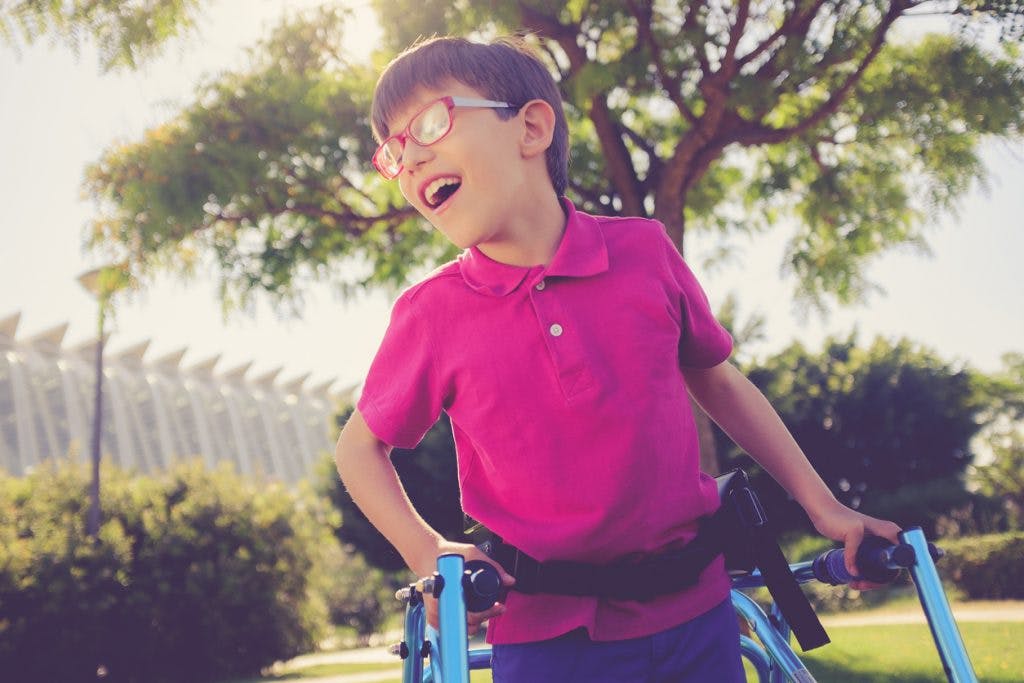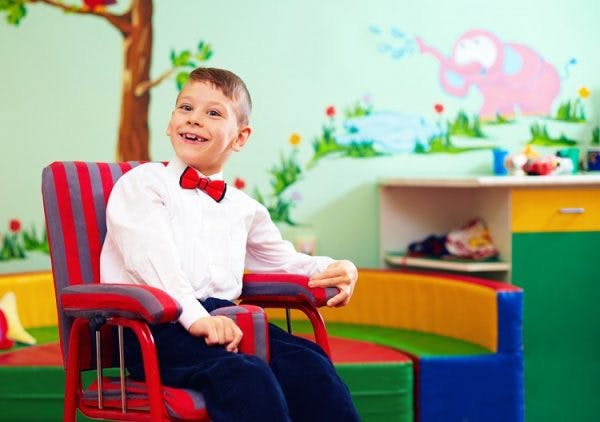When children are learning to walk, they may walk only on their toes for a time, rather than taking the typical heel-to-toe steps. However, while toe walking as a toddler is completely normal, it should phase out by age 2. If children with cerebral palsy continue to walk on their toes past 2 years old, it’s most likely because spasticity in the calves is pulling on the heels and keeping them from reaching the ground. As the child continues to grow older, spasticity may continue increasing, and toe walking may become a habit that’s very difficult to break.
To help you get a better idea of what toe walking is, this article will go over its:
What Causes Toe Walking in Children with Cerebral Palsy?
Toe walking in individuals with cerebral palsy is primarily attributed to spasticity, which refers to involuntary muscle contractions caused by damage to the brain. Spasticity can pull the limbs in abnormal positions and cause stiff movements.
Over 80% of individuals with cerebral palsy experience spastic CP, which explains why abnormal gait patterns like toe walking are so prevalent among this population. Toe walking occurs most commonly in individuals with a type of spastic cerebral palsy that primarily affects the legs called spastic diplegia.
If spasticity isn’t properly managed, the affected muscles in the calves will only become tighter. This can make toe walking even more challenging to reverse. Therefore, early intervention will help minimize chronic pain and correct form before the abnormal gait pattern becomes a habit. In the following section, we’ll discuss additional risks associated with toe walking.
Risks Associated with Toe Walking and Cerebral Palsy
Toe walking caused by cerebral palsy can range from mild to severe. While the brain damage that causes cerebral palsy will not worsen over time, secondary effects of that damage such as spasticity can.
The progression of spasticity in the calves can cause toe walking to become more severe and put children at risk for many other complications, including:
- increased risk of falling due to poor balance and stability
- chronic pain due to muscle tightness and excess pressure on the ankles
- poor posture due to altering center of gravity
- non-ambulation (inability to walk)
Early intervention is crucial to ensuring that spasticity does not harm your child’s growth and development or affect their quality of life. In the following section, we’ll discuss effective ways to correct toe walking.
Want 19 pages of CP recovery tips in PDF form? Click here to download our free illustrated ebook now (link opens a pop up for uninterrupted reading)
How to Correct Toe Walking in Children with Cerebral Palsy

In order to correct toe walking in children with cerebral palsy, you have to treat the underlying problem: spasticity. Since spasticity is not caused by damage to the muscle itself, but rather by damage to the brain, therapy will focus heavily on promoting neuroplasticity. Neuroplasticity refers to the brain’s ability to rewire itself and recover functions affected by brain damage.
The best way to activate neuroplasticity is through lots of repetition. By consistently encouraging your child to practice using correct form, they can rewire the brain to develop better walking habits and overcome toe walking.
Below, we’ll discuss some of the most widely-utilized interventions to treat spasticity.
Physical Therapy
Physical therapy is one of the first treatments your child’s doctor will recommend for treating toe walking. A physical therapist will assess the severity of your child’s toe walking and create a personalized exercise regimen that focuses on lengthening tight muscles, strengthening underused muscles, and practicing standing and walking with correct form.
Many physical therapists use fun games and activities in addition to exercises to address toe walking and encourage carryover of skills learned in therapy to a child’s daily life. Some activities they may use to address spasticity in the calves include practicing various animal walks (such as the bear crawl) and trying to stay balanced on a wiggly surface.
Orthotics
Wearing orthotic devices like leg braces and casts help ensure that the joints in the foot are properly aligned. A leg brace or cast will keep the heel down and stretch the muscles in the calf so that your child can learn to walk correctly. If the spasticity is relatively mild and addressed early on, a child may be able to wean off of using the orthotic over time.
Botox
Botox injections are injected into overactive, spastic muscles to reduce tone. It can help temporarily reduce spasticity so that individuals with cerebral palsy can practice walking without spasticity.
Practicing walking with an improved gait pattern can help children develop new and proper walking habits, and can help keep spasticity in check even after the Botox wears off. However, Botox is only approved for children 2+, so to address toe walking in your child before that, other treatments must be used.
Baclofen
Baclofen is a drug that can be taken orally, injected, or pumped into the body to relax spastic muscles.
However, the most popular and effective way baclofen is administered is through an intrathecal baclofen pump. The pump must be surgically implanted under the skin of the abdomen. Since it is directly infused into the spinal canal, baclofen can be delivered in smaller, safer doses.
Surgery
Surgeries are often considered a last resort and are typically only recommended if all other treatments prove ineffective.
Selective dorsal rhizotomy is a surgery that involves cutting specific sensory nerves to permanently reduce spasticity in a muscle. When that nerve is cut off, it can’t grow back, so the muscle can no longer become spastic.
Manual muscle and tendon lengthening surgeries are also commonly performed to combat spasticity in individuals with cerebral palsy.
Understanding Toe Walking in Children with Cerebral Palsy: Key Points

Minimizing spasticity is only the first step to correcting toe walking in children with cerebral palsy. Next, your child has to learn how to stand and walk correctly. It might feel weird or uncomfortable, but the more your child practices walking correctly, the easier it will get.
We hope this article helped you understand why individuals with cerebral palsy experience toe walking and how to correct it.











